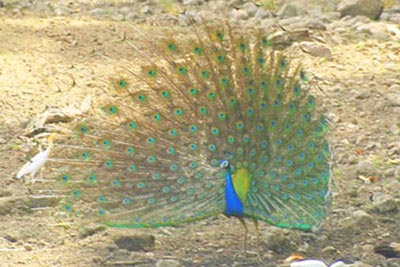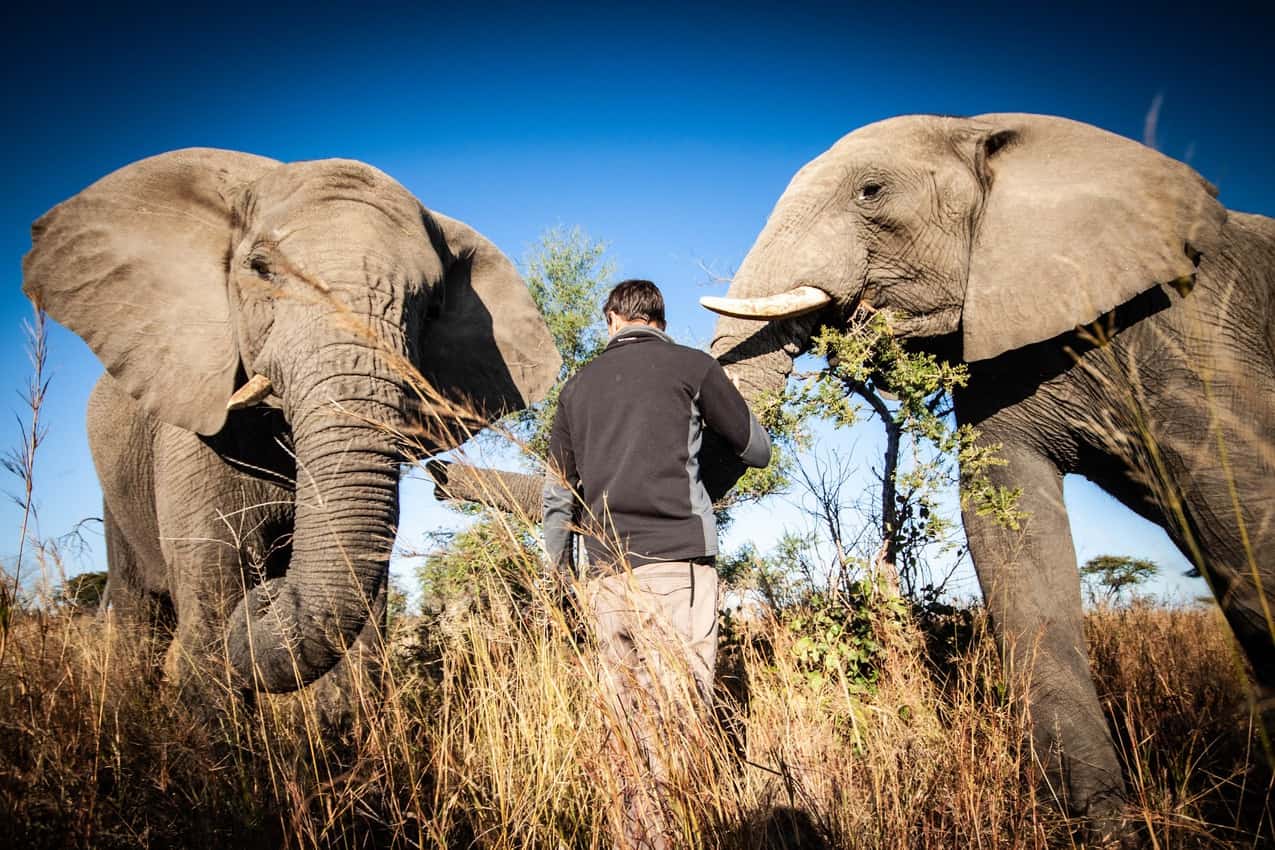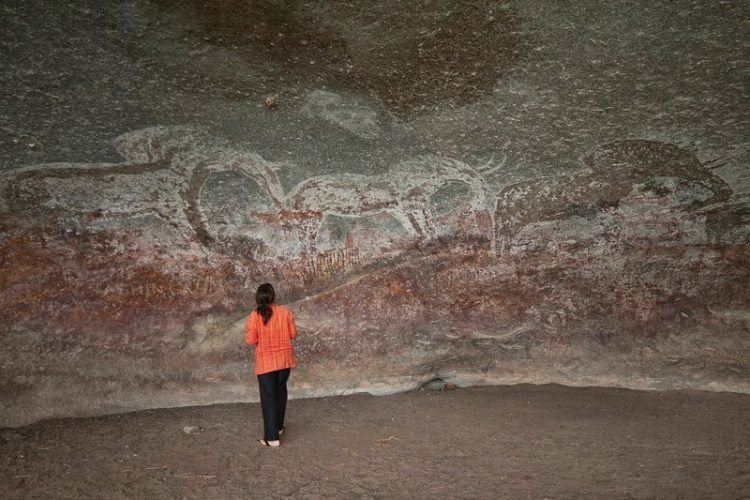
Zimbabwe: Granite Castles and Ringing Rocks at Matopos National Park
By Rene Bauer and Andrea Kaucka
Zimbabwe – the “house of stone“ – is one of our favorite countries in Southern Africa, a country that, despite its turbulent past and gruesome present, holds for us a special kind of attraction and really is so very different from its neighbors.
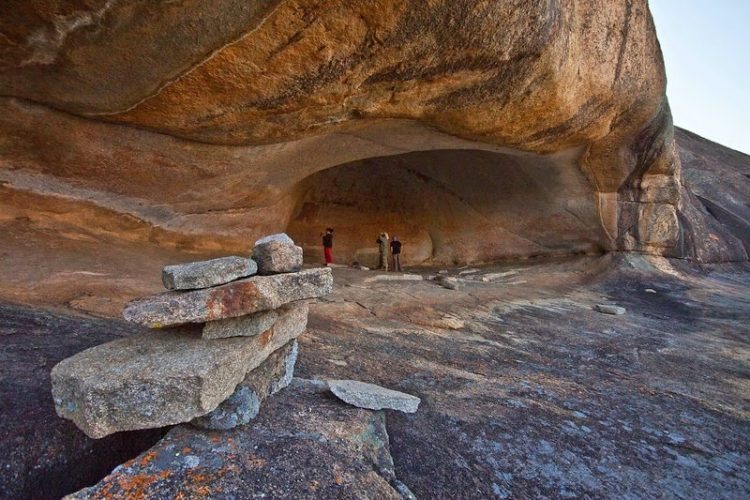
We have spent a lot of time here, crawled around in the remotest corners, and simply fell in love with its scenery and inhabitants alike. And within this country, there is one place that holds an even more special kind of attraction for us, a place of outstanding beauty and scenery – Matopos National Park.
Meeting up
Can you rely on a person without a mobile phone, email address, or any other device of our 21st-century technology? This was the question Andrea and I asked ourselves when entering Zimbabwe through the Plumtree border and making our way towards Bulawayo, the capital of Zimbabwe´s Matabeleland.
We had met Graham and Bianca in the Hlane NP in Swaziland, two extraordinary people touring Southern Africa in their Landrover. Graham, more looking like Bob Marley than a white Zimbabwean, had claimed to be the grandson of Cranmer Kenrick Cooke, a Zimbabwean archaeologist who had discovered and analyzed San cave paintings in Rhodesia (in the olden days) and had written various books on the subject.
We were a bit doubtful but had agreed to meet up with them on the municipal campground in Bulawayo at a certain date. No connection with them in between, just a word from Graham that they would be there.
Still, in Hlane we had made a plan with these two that we would take a closer look at Matopos NP together as Graham had often been there as a little boy and knew a few undiscovered corners of this park.

The Answer is Yes
To answer my first question above – yes, you can rely on someone like that because we met Graham and Bianca, not on the municipal campground though, but at his relatives´ who own the Chipangali Wildlife Orphanage 20km outside Bulawayo.
We were impressed! All we still had to do was stocking up on food, diesel and water, plan our route and set out on this little expedition. Andrea and I had been in Matopos before, but not as intense as this time.
Painted Rocks
Coming into Matopos is like landing on a different planet. It is an absolutely magical landscape composed of granite hills, called “kopjes“, huge monoliths called “whalebacks” and soft, golden plains in between, dotted with acacia trees.
There are rivers, little dams, and lakes. Matopos is a national park of a different kind – one doesn’t come here for the animals, but for something much more intriguing than that – marks of Southern Africa´s first ancient inhabitants.
The whole area spreads out over 3100 km2 but only 424 km2 had been made a national park in 1926.
Zimbabwe’s Oldest Park
This makes it the oldest park in Zimbabwe, which, because of its rich cultural heritage is even on the UNESCO list of world heritage sites. When driving through, imagination just goes absolutely wild – the rocks start looking like castles, camels, mushrooms or people, sometimes delicately balancing on top of each other.
Already from far, we can see one of Matopos´s symbols, the rocks called “mother and child.” Sir John Cecil Rhodes, the famous British explorer lending the former British colony his name, was so impressed by it that he wanted to be buried in these granite hills.
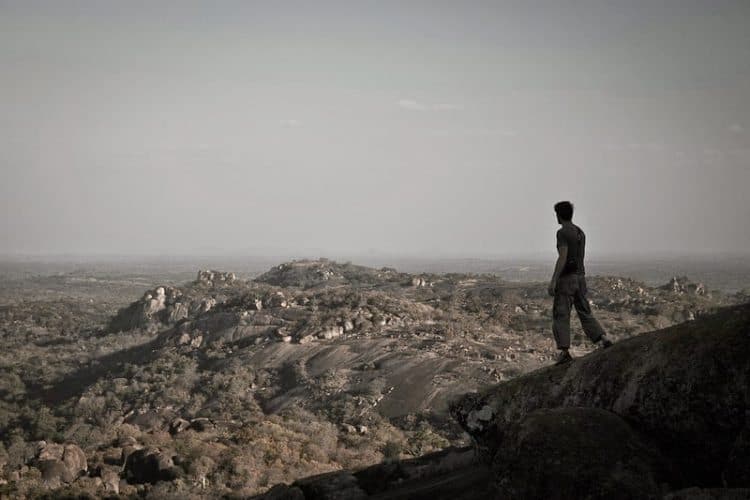
This awe-inspiring scenery has been shaped over millions of years, time using wind and water as its tools to shape those granite rocks. This created a landscape full of overhangs, caves, shelters, and balancing rocks — a perfect base for early human settlement.
Southern Africa’s real natives – the San people or Khoisan, left their marks all over Zimbabwe with the highest concentration of cave paintings being in Matopos. Those paintings are between 2000 and 6000 years old and considering their age, most of them are still in very good condition.
Why though, did the San decide to live in the Matopos area? They were hunter-gatherers, heavily relying on constant food supply, they didn´t cultivate, they lived off the land, collected wild plants, nuts, and fruits and hunted or trapped wild animals.
Matopos is very rich in both, plants and wildlife alike, it´s like a very own little ecosystem, surrounded by granite hills. There was a good supply of water and that meant enough wildlife as well as rich vegetation.
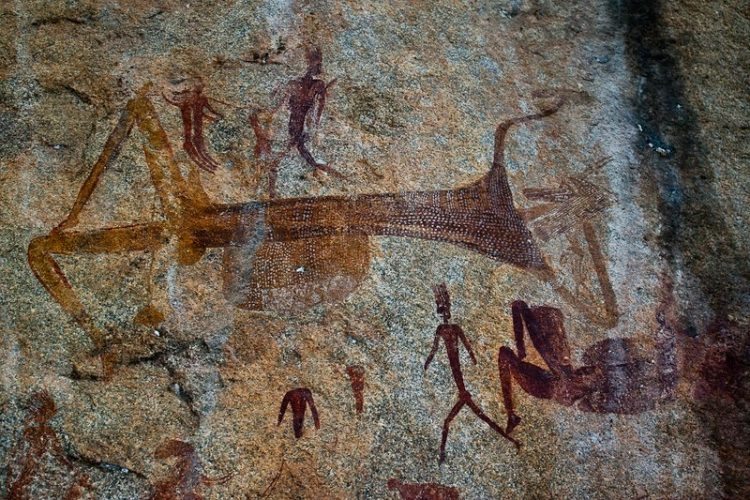
Many Cave Paintings
The number of cave paintings in that area proves that fact. The San lived in groups of up to 25 people, mostly they used overhangs and caves as shelters to live under. It´s in these places that cave paintings can be found. Mostly drawn by their Shamans, these paintings represent their cultural heritage, their „language“ and visions.
Mostly, those paintings express daily life in the Matopos for the hunter-gatherers and we could get a good idea of what their life was about. It gets much more complicated to guess their spiritual world, there are paintings of people with animal heads, giant snakes carrying people, long oval shapes – all in all very intriguing and for us “modern” visitors it proves very hard to guess what it all means.
When studying various paintings closer we can clearly see the different drawing styles that were used, some paintings look more or less primitive, others show intricate patterns and very high accuracy as well as well-drawn animals and people.
Siloswane Cave
It took us a while in Siloswane cave, for example, to find out that those 2m long shapes were not horses with tusks but elephants! What is also very interesting is that a lot of the Sans´ flintstone tools and beads have been found around those caves, which gives us a much better insight into their life and culture.
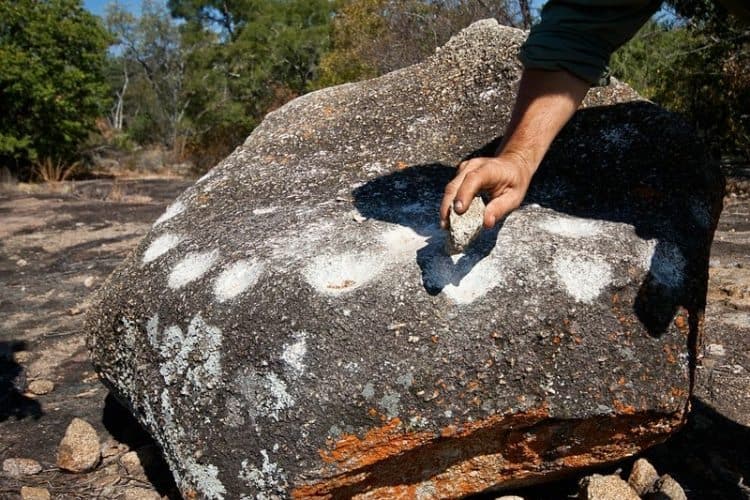
Tragic Vandalism
There are a few famous and big caves in the Matopos, those are well visited and unfortunately have taken a lot of damage from visitors. It drives us absolutely mad to find charcoal writing on top of the paintings, saying “Steve was here“ or something along those lines.
Pomongwe Cave with its adjoining visitor center is a good example, the paintings here are faded and can hardly be seen, one “archaeologist“ even tried to protect them with painting clear oil over it – and thus destroying them even more.
Unforgettable Magic
But once one stands on top of a mountain right at the entrance to the cave and looks over the surrounding scenery it quickly becomes clear why the San people chose these places – the magic here is unforgettable and the views are breathtaking.
The San paintings of the Matopos though are not only under threat of destruction by tourists and Bantu tribes, they all too often fall victim to natural erosion, weather influences, and exfoliating granite.
We had made camp at Maleme dam a few kilometers away from the Visitor Centre, from there we set out every morning to explore the granite hills of Matopos and to discover more cave paintings. What a nice feeling it is to wake up to the calls of the Chacma baboons, seeing their silhouettes sitting high up above our camp.
Graham didn´t only know a lot about the San but was also a great ornithologist, naming nearly every bird around us.
Rock Gongs in the middle of nowhere
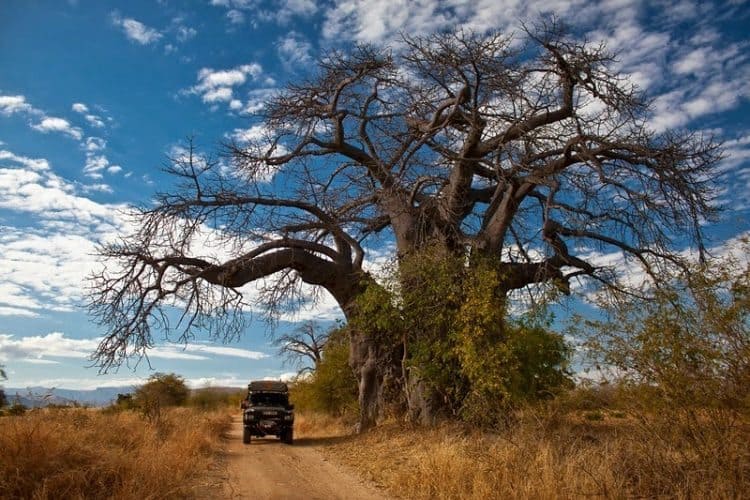
All through the whole visit to Matopos, there was one thing which excited us the most – finding the ringing rocks or “rock gongs” of the Matopos Hills. Graham remembered seeing them as a little boy but wasn´t too sure anymore where to find them. We made it our private little expedition to go deep into the hills and find them.
The only thing Graham remembered was a little turnoff off one of the main tracks, we found it and followed that track. Well, track is an overrated word, it soon became a little trail, and a few more kilometers on we advanced in walking speed, basically pushing our cars through the man-high grass, dodging bushes and branches, often pausing to walk ahead and check out the terrain.
The good thing was that we had two cars which gave us much more confidence than being alone, especially when discovering unknown, remote areas. The feeling of being on a different planet got stronger the more we explored Matopos from this unknown side.
Sometimes we went in narrow valleys and then suddenly the most beautiful, breathtaking views would open up with all these granite „castles“ lying basically to our feet, stretching out as far as the eye could see.
A Familiar Rock Formation
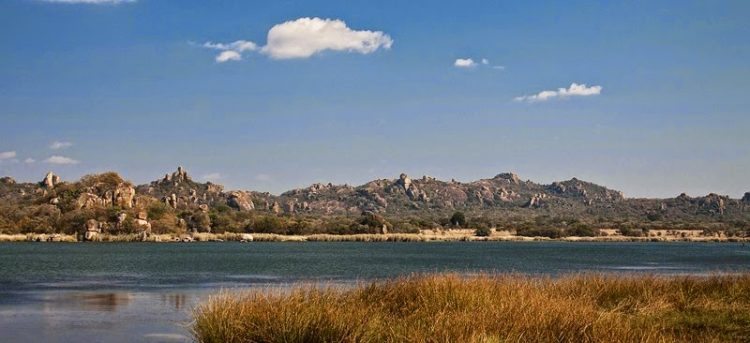
Sometimes Graham remembered a rock formation he had seen as a little boy so we sort of knew we were on the right track. Soon after we had manoeuvered our cars over one rough rocky patch the trail, or better what was left of it, suddenly disappeared and we came onto a grassy plain surrounded by granite hills
Ringing Rock?
Should that be the end of our expedition “ringing rock”? On the other side though we saw some movement and realized those were locals cutting the long grass to make thatch for their roofs. As they didn´t speak English, Graham used his knowledge of the local dialect. And bingo, they understood what we were after!
One woman showed us the way and we got excited! We had to walk another 20 minutes, discovering more rock paintings on the way and then already from far we could see those ringing rocks – unmistakably they looked like giant round marbles scattered on a huge rock face, deep hollows in their sides from hundreds of years of drumming.
Rock Gongs
We all looked at each other and smiled. We had found them! Next thing was Rene and Graham picking up small rocks and starting to hit the first rock gongs. It sounded like a metallic drum, apparently, they were used to gather surrounding tribes and chiefs for a meeting, or simply to play music on them in some local ceremonies.
Some made more sounds than others, but all had those white, cup-like markings on them. That surely is a thing not many people know about Matopos and for us, it added to the already stunning beauty of this national park. When we had to leave after nearly one week, we felt a little sad heading back to civilization – all those granite “kopjes“, rock paintings and magic of this stretch of land had put us under its spell.
- Arctic Winter Adventures in Sweden and Norway - January 10, 2021
- Kissed By an Elephant in Zimbabwe - November 22, 2020
- Sudan: Searching Bir Nurayet’s Treasures - November 13, 2019




